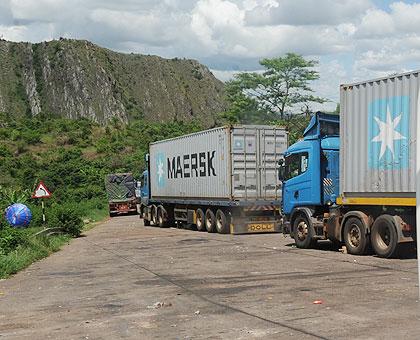The controversy over the amount of cargo trucks leaving the port of Mombasa can transport on Kenyan roads has ended after the East African Community Ministers endorsed the 2012 Vehicle Load Control Bill which seeks to harmonise load limit in the region.


The controversy over the amount of cargo trucks leaving the port of Mombasa can transport on Kenyan roads has ended after the East African Community Ministers endorsed the 2012 Vehicle Load Control Bill which seeks to harmonise load limit in the region.The bill seeks to reduce incidences of overloading on the region’s road network, but it took the whole of last week, at a multi-sectoral meeting in Nairobi, by technocrats and Ministers responsible for Roads, Transport, Trade, EAC Affairs and Judicial Affairs to hammer out the deal.At heart of the row were differences on how much payload member states should allow on their roads. Kenya allows a maximum of 48 tonnes for vehicles, Rwanda and Burundi 53 tonnes while Tanzania and Uganda allow 56 tonnes, which created hurdles for trucks from neighbouring countries ferrying cargo on Kenyan roads. Trucks from the Uganda, Rwanda, Burundi, Southern Sudan and the Democratic Republic of Congo were often held at weighbridges on Kenyan roads A uniform axle load for the five East African countries will significantly increase the pace of clearing cargo at the weighbridges, eventually lowering the cost of transportation. It will also eradicate complaints about corruption and extortion on Kenyan roads.A cargo cleared in any of the countries will now move freely without having to be tested at each weighbridge as has been the case.The issue of payload and corruption had seen truckers load their trucks with cargo way beyond the allowed weight. This badly damaged Kenyan roads, leading to President Mwai Kibaki to issue a decree lowering axles from four (64 tonne) to three, and reducing the limit of the gross weight of a truck to 48 tonnes. This led to protests from exporters and the business community from the region. Kenya, however, stood its ground which led to the matter taking too long to be resolved by the EAC.Speaking to The New Times yesterday, Dr. Alex Nzahabwanimana, the State Minister in the Ministry of Infrastructure in charge of Transport, said the Bill is vital since it puts an end to wear and tear of roads in the region. "The Bill is necessary for the region and is a welcome decision that the EAC partner states have committed themselves to progressively address those bottlenecks leading to high costs of transport and logistics,” he said.It also aims to give legal force to an agreement reached last year among EAC states that sets the axle load limit to 56 tonnes for commercial vehicles plying the regional road network.Dr. Enos Bukuku, the EAC Deputy Secretary General in charge of Planning and Infrastructure, said that with the harmonised legal regime to govern vehicle loads in the region, businesses and governments in the EAC stand to register an estimated US$1 billion in annual savings from reduced transportation and maintenance costs, respectively."In addition to lowering the cost of doing business in the region, governments in the EAC partner countries stand to benefit from the improved regional axle load control oversight procedures and the regional ICT connectivity of the weigh scales which the Bill envisages,” he noted.Bukuku added that as world markets become progressively liberalised, it will be the markets that have the lowest transport and logistics costs that will attract investors, industrialists and new capital. 'The agreement was critical as it will now lead to efficient logistics for transit transporters who used to suffer the costs of differentiated axle loading limits.' EAC director of infrastructure, Philip Wambugu, said recently.The bill is now due for consideration by the EAC Council of Ministers before it is finally forwarded to the East African Legislative Assembly (EALA) for debate and enactment into a Community law which shall be applicable in the entire five-member bloc.'This agreement was critical as it will now lead to efficient logistics for transit transporters who used to suffer the costs of differentiated axle loading limits,’' said Wambugu. If passed, the Bill would mean payments of overloading fees will be done administratively through prepaid coupons or electronic transfers, thereby eliminating payment through the court systems, among others.Abdul Ndarubogoye, the Vice- Chairman Rwandan Transporters' Association, said the region has achieved a landmark decision, noting that the Bill will be crucial in tackling a serious Non- Tariff Barrier in the form of different axle load limits.A regional study recommended that the region adopts a harmonised load limit, decriminalises overloading and develops modern weighbridge stations.An agreement on a uniform gross vehicle mass of 56 tonnes on seven standard axels for the region was consequently reached at in August 2011.The study on harmonisation of axle load control laws and regulations in the EAC was funded by Japan International Co-operation Agency (JICA) through a grant to the EAC Secretariat and conducted by PADECO Co. Ltd.It identified issues that needed to be harmonised and agreements had been recorded in 24 areas covering aspects such as legal instrument, calibration of weigh bridges, computerised scales, and standardisation of technology.According to a summary from the EAC Secretariat, the two outstanding issues that had blocked the harmonisation process were the use of gross vehicle mass on seven standard axles and use of interlinked vehicles.


